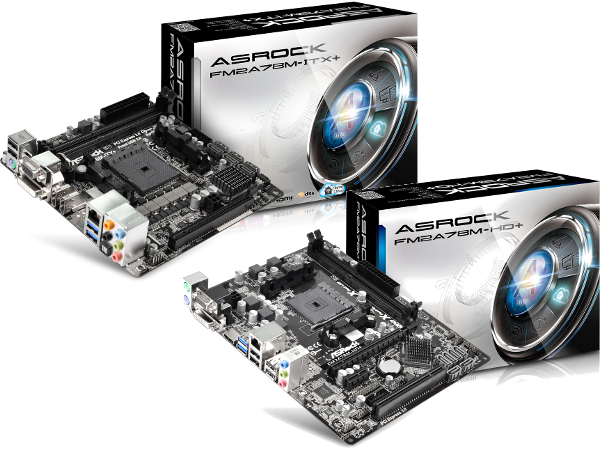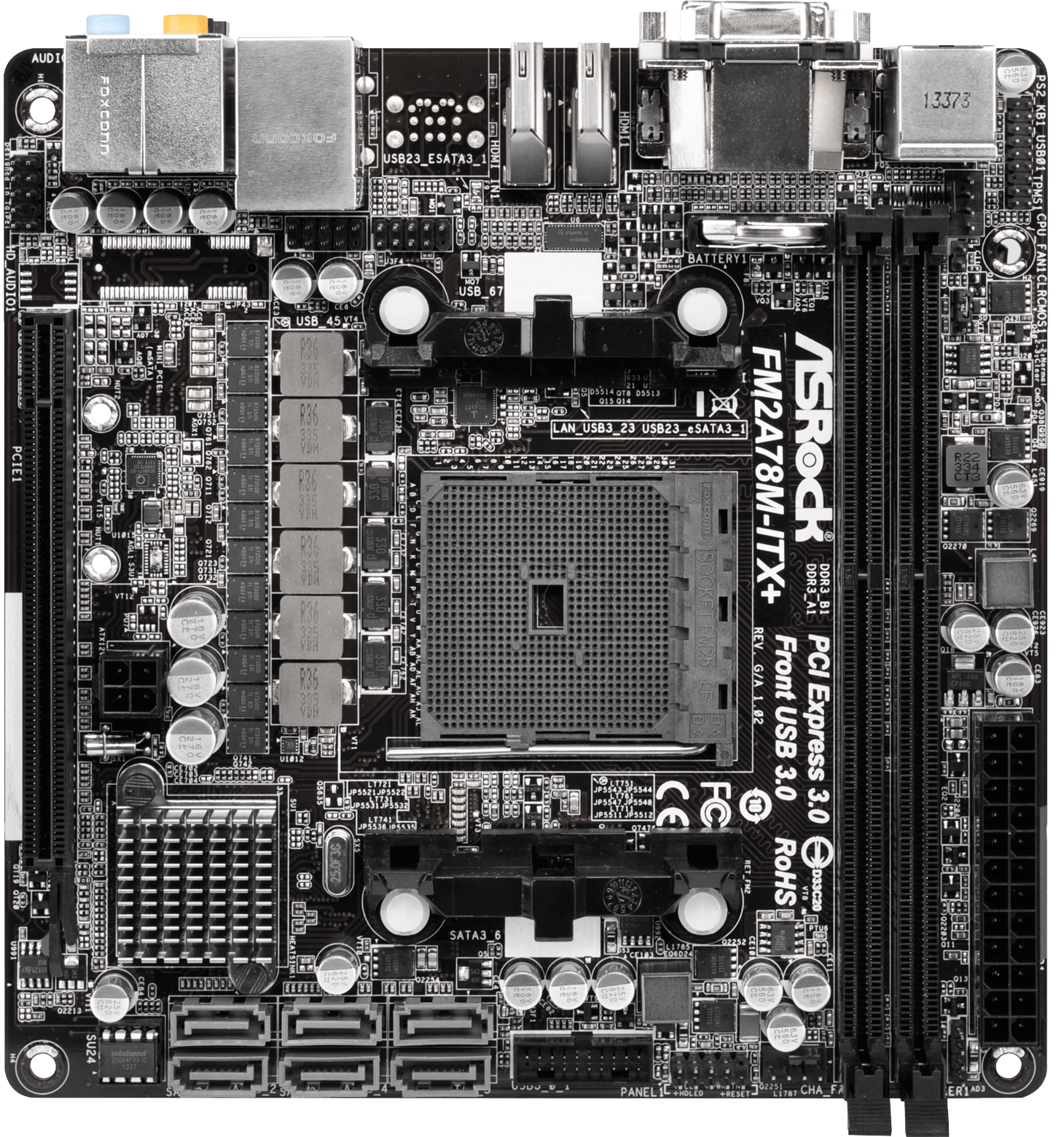Early Verdict
If you're building an HTPC and can find this board on sale, it's a steal! Even at retail price, the efficiency and performance of this board earn it the Tom's Recommended Board award.
Pros
- +
Cool • Digital audio out and HDMI-In • Efficient
Cons
- -
Price • Very tight fan-header placement • 12V power location
Why you can trust Tom's Hardware
Specifications, Firmware & Software
In my previous installment, covering AMD's A78 chipset, I looked at boards from MSI and Gigabyte and was quite pleased at their performance compared to the higher-end A88X chipset as well as Intel's H81 budget offering. Given the target audience of the A78 chipset, this solution will work perfectly for entry-level enthusiasts or builders wanting to construct an AMD-based HTPC.
To the uninitiated, A78 is AMD's "media-class" chipset for the company's FM2+ APUs. Though this chipset lacks a second PCIe x16 slot and retains less RAID capability, it appears to be potent enough to fit many builders' needs. I've been scratching my head over this topic lately, and I just can't think of a reason why I would use an A88X over the A78. If I am going to buy an AMD APU, I don't necessarily need a GPU, let alone a CrossFire configuration. Plus, if I had aspirations to do CrossFire, wouldn't it be more logical to upgrade to an AM3+ board and get some real horsepower? If the AMD APU is truly meant for HTPC, office and casual gaming tasks, shouldn't I look for the smallest, most efficient motherboard I can find? Sure, with the higher-end, A88X boards we get better components, access to more features and peripheral connectivity, but some of the A78 boards I've looked at show plenty of potential.
| Header Cell - Column 0 | FM2 | FM2+ | Header Cell - Column 3 | |||
|---|---|---|---|---|---|---|
| Row 0 - Cell 0 | A85X | A75 | A55 | A88X | A78 | A68H |
| PCI Express | 1x16 / 2x8 | 1x16 | 1x16 | 1x16 / 2x8 | 1x16 | 1x16 |
| SATA (6Gb/s) | 8 (8) | 6 (6) | 6 (0) | 8 (8) | 6 (6) | 4 (4) |
| RAID | 0, 1, 5, 10 | 0, 1, 10 | 0, 1, 10 | 0, 1, 5, 10 | 0, 1, 10 | 0, 1,10 |
| RAID Driver | Promise | Promise | Promise | Dot Hill | Dot Hill | Dot Hill |
| USB (3.0) | 14 (4) | 14 (4) | 14 (0) | 14 (4) | 14 (4) | 10 (2) |
* Per AMD's site - FM2 Easy upgrade path featuring latest USB and SATA technologies. FM2+ Backwards compatible, future-ready and PCIe Gen3.0 ready.
To round out my analysis of the chipset, ASRock has provided me with two samples to run through the test suite. Though they have the same chipset, they each have different features that can be useful for both target business segments.
Specifications
MORE: Best Motherboards
MORE: All Motherboard Content
Firmware & Software
ASRock's UEFI is a familiar sight to the Tom's Hardware crew — it has that old-fashioned BIOS feel that I know and am comfortable using. The two motherboards in this review show similar options, so I'll be grouping them together for a brief overview.
The opening screen has the usual memory and APU information listed, and a row of icons for various sections, such as OC Tweaker, Boot and H/W Monitor. ASRock made it fairly easy to navigate to the main areas of interest, and provides a brief description on the right side of the screen of what each selection can do. This might seem irrelevant to the advanced tuner, but some of the options can become quite confusing as we are led further down the rabbit hole.
Get Tom's Hardware's best news and in-depth reviews, straight to your inbox.
For my purposes, OC Tweaker and Advanced screens are the most interesting, since those screens are where most tweaking occurs. OC Tweaker provides access to the APU/PCIe clock, processor multiplier and voltage, and APU load-line calibration. Going a few options further, DRAM timing is accessible, and users can tweak for maximum effectiveness. For the purposes of this review, default memory timings are used, and the XMP profile is applied for overclocking stability tests.
With the Advanced menu, even more detailed features are available. Cool 'n' Quiet, Thermal Throttle, Dual Graphics and Onboard HD Audio options are listed (when applicable) and can help achieve system-specific settings that will enhance the target application.
Both boards offer ASRock's A-Tuning utility, but the ITX+ does offer a couple of other features worth mentioning, such as HDMI-In and HomeCloud. In order to utilize HDMI-In, A-Tuning must be installed and the option switched from Onboard to HDMI from within the OS. Once HDMI-In is enabled, or when the system is off or in standby mode, the motherboard acts as an HDMI pass-thru and will output whatever device is connected through the motherboard onto the PC monitor. I was hoping to see this behave more as a TV tuner card given the lack of expandability on the board, but perhaps some third-party tools will enable such a feature. HomeCloud (through Sunlogin) can be installed to give remote devices such as tablets and smartphones access to control the client. This could be incredibly handy for users who need to start their PCs on the go or download files from their computers, or for parents who need help turning on that one video that their child loves but is buried in a maze of folders.
Current page: Specifications, Firmware & Software
Next Page FM2A78M-HD+ & FM2A78M-ITX+ Layout-
FCsean At the time of this writing, three of the four boards retail for an average of $60. However, the ITX+ board is retailing for nearly 60 percent more at $84.99!Reply
Not sure how 84.99 is 60% more than 60. maybe 40%. -
ktolo I still don't know why i keep seeing APU's tested with 1600 memory.. when the world and his dog knows that when you pair these chips with faster memory it unlocks a fair bit more performance. 2133MHz minimum for these APU's - the 7850K can work with 2400MHzReply -
Onus ktolo, you have a point for actual use, however he did mention in the beginning we're all using the same RAM which can allow some direct comparison across all our motherboard review articles.Reply
For my part, as I test a variety of systems, despite sometimes notable benchmark differences, there is little practical difference in the end-user experience. In the bad old days of single and dual-core CPUs, everything mattered at the margin; now I think that is less true. This may be why AMD still manages to sell CPUs, as long as the price is right. Intel may indeed run rings around them, but in actual use the difference doesn't feel that great. -
TheTerk ReplyAt the time of this writing, three of the four boards retail for an average of $60. However, the ITX+ board is retailing for nearly 60 percent more at $84.99!
The ITX+ retails on Newegg for $95 bucks. It is currently on sale for $84 and it looks like the rebate is still available until the end of January.
Not sure how 84.99 is 60% more than 60. maybe 40%. -
Crashman We love the Terk. Unfortunately, motherboard companies aren't loving AMD at the moment: Getting samples has been a problem. So if anyone knows about something released in the past year that we should have tested, speak up and we'll pester those companies.Reply -
damric I have been known to crossfire on the A88X platform. The platform has numerous advantages over AM3+, including PCIE 3.0, CPU on-die northbridge, and lack of Hyper Transport bottleneck. Also Steamroller cores have more IPC and twice as many decoders per module as Piledriver cores. I'm not sure why anyone would purchase an AM3+ platform at this point actually, unless getting one very cheap second hand.Reply -
RedJaron Jake, as you say, A88X boards tend to have somewhat better components than A78 boards. To the APU tweaker and tuner, the higher quality board would be appreciated in OCing. The value of FM2 and APU OCing is of course a whole 'nother topic, but if you're going to do it, I would generally prefer an A88X board.Reply
You are quite right that a media and HTPC can do well on the cheaper A78, just like I'd go with a B85 or H81 on the Intel side for such a machine. -
logainofhades The newegg link, for the M-ITX board, on the last page, takes you to the M-ATX one, for some reason.Reply -
Rexolaboy DDR3 1600mhz with an APU? At least see how adding the 2133mhz ram improves performance. We see overclocked GPU's in reviews, you even oced the CPU in this review, but 1600mhz ram is almost pointless in an APU platform, especially when the price difference is maybe $10-$15 for 2x4 gb. I would have liked seeing a current review of AMD Dual Graphics with the motherboard and new Crimson Drivers. Guess I'll have to watch more foreign youtube videos.... :(Reply


